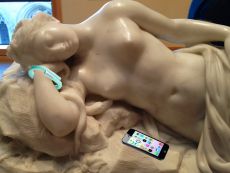Sleep
Monitoring the Rest You Need, All on Your Wrist
Measuring your sleep with gadgets
Posted August 8, 2014

What would a wearable gadget have monitored? No statues were harmed in creating this image using Acorn and Apple Aperture.
Recently, I attended a scientific meeting about sleep, and a question arose regarding how many people were using a gadget to monitor their health and their sleep. About half of the 15 people in the room sheepishly raised their hand and showed that they were indeed wearing such a gadget on their wrists. I was one of the people who raised their hand. I had received it as a Father's Day gift. Perhaps the gesture was a hint that I was not sleeping or exercising enough. All of us in the room agreed that we had no clue about whether the monitoring of sleep by these gadgets was accurate.
These gadgets (sometimes called "wearables" or “fitness trackers”) go by different names that include Flex, UP, Gear, Fuelband and are being marketed by heavy hitters in technology including Fitbit, Jawbone, Samsung, and Nike. Most of these gadgets link to smartphones running either Android or iOS. The Android operating system contains Google Fit for Android. Apple’s new operating system for mobile devices, iOS,8 contains an app called Health with the ability to communicate with devices you might have (e.g. Jawbone Up, Resmed S+) and track sleep. Microsoft has recent announced the Microsoft Band (a watch like device that monitors several variables including sleep). The game maker Nintendo is also getting into the sleep space.
The devices that are worn on the wrist contain an accelerometer which basically measures motion. In addition, these devices contain the ability to communicate with either a smartphone or a computer. Some are self-contained; with all of the data appearing upon a display on the gadget itself. I will comment primarily on the ones that communicate to a smartphone, because I have had personal experience with one for several months.
How do these work, and how do they monitor sleep? Scientists have been using devices that track movements for at least 30 years with a theory being, if you move a lot you are probably not asleep. The devices, called actigraphs, can be a decent rough measure of a person’s sleep time and have been used in sleep research. They were not really used to determine type of sleep.
Some of the newer gadgets tell you how much "restful" sleep vs. light sleep you have had. I have no idea how they can do that, and if they can do that with accelerometers alone. I have been looking at brain waves using EEG to document stages of sleep in patients for the last 30 years, and I can tell you that even with the combination of brain waves and video, it isn’t always so easy to determine whether a person is asleep and whether their sleep is deep or not. Some of these devices claim to wake you up at a perfect time, when you are not in deep sleep: a physiologic alarm clock.
You would think that the gadget ought to be able to tell whether you are awake or asleep. However, one model requires that the user press a button when getting into bed, and pressing the button again when leaving the bed. If you don’t press the button I just mentioned, the system becomes extremely confused and may assume that you hadn’t slept at all. In my experience even when you do press the correct buttons, the units can become confused and tell you that you hadn't slept, when in fact you had a lovely seven hours of sleep. One user told me, and I documented this, that the gadget thought she had slept 2.5 and 3.5 hours during two consecutive nights, respectively, when in fact the gadget was sitting not on her wrist, but on a nightstand. When the user pressed the buttons at the right times (bedtime and morning), it seemed pretty accurate in calculating the number of minutes it took to fall asleep, and how many awakenings there were during the night. My overall impression is that when used as directed, the devices do give you a trend. Most of the time they will tell you that you haven’t slept enough, and that is something you already knew.
Another approach used by some devices is to monitor the sleep environment (the person, breathing, room, bed, pillow). One can pack a lot of sensors into a device that can track heartbeat, breathing, movement, and noise. Three that come to mind are the S+, Hello Sense and the Beddit.
Are any of these gadgets accurate at monitoring sleep? They have barely been studied. I could only find one rigorously done study which evaluated one wrist-word device which concluded that it will "consistently misidentify wake as sleep and thus overestimate both sleep time and quality.” (Please let me know if there are other peer-reviewed articles.) Biomotion sensors have been used to assess sleep and appear promising. A example of a report using S+ technology is found here. Such technology has been evaluated in sleep apnea.
The second popular function on these gadgets is to measure activity, the number of steps you have taken. This function is identical to the pedometers that started to become popular several years ago.
These electronic step counters convert the number of steps into distance, and then calculate how many calories you have burned moving. This type of monitoring can be done with a gadget worn on the wrist, or attached elsewhere to clothing, or can be done with a smartphone since most have an accelerometer built in. Are they accurate? When I used two different gadgets to measure the number of steps I took, over several days, the values between the two gadgets were never identical. They usually varied by 5 to 15 percent. The fact that these devices are not equally accurate has been reported. What is interesting is that they are starting to be used in medicine.
Does it matter that the devices are not perfect for sleep and activity? I do not think it matters very much. We are not measuring blood glucose levels, or oxygen levels that might require an acute intervention. They are giving us trends that can be very helpful and can be used to change some of our health behaviors. We have known for many years that whatever is monitored can be improved.
When I first received my gadget, one of the first days I used it I had an all-day clinic at a facility that required a one-hour drive in each direction. After such a long day, I came home, my gadget told me that I had taken less than a thousand steps (mostly walking to and from the parking lot of this hospital), and not even 10 percent of the number of steps I should be taking daily. To me, this was a wake-up call. My weight had been creeping upwards. I programmed the gadget to vibrate every 15 minutes when the gadget detected I was "idle" and prodded me to move. As a result of changing my behavior, I have returned to my optimal weight.
I have been involved in measuring blood oxygen levels, carbon dioxide levels, electrocardiograms, brain waves and muscle activity, during sleep for many years. I can easily envision how gadgets can be designed to measure many of our body's functions (and some already have). The next few years will be fascinating, because I am sure that brilliant minds are developing the methods to measure these functions, and to transmit them to a smart device.
Devices are being evaluated that are worn not as a bracelet on the wrist but attached to the skin using a thin band-aid that has embedded miniature sensors that can monitor movements, electrocardiogram, and temperature. An example is the Biostamp. As mentioned above, some gadgets are not worn by the person but are placed in the room or bed.
This field is not as far-fetched as it sounds. Recently, Google and a contact lens manufacturer announced the possibility of developing products that can monitor blood sugar levels using a contact lens. Hey, if you could measure glucose levels, you could probably also measure a bunch of other chemicals, and if you put a tiny accelerometer into the contact lens, you would probably be able to tell when the patient is dreaming! Maybe even what they are dreaming.
Montgomery-Downs HE, Insana SP, Bond JA. Movement toward a novel activity monitoring device. Sleep Breath. 2012 Sep;16(3):913-7.
Lee JM, Kim Y, Welk GJ. Validity of Consumer-Based Physical Activity Monitors. Med Sci Sports Exerc. 2014 Feb 5. (Epub ahead of print).
Albert MV, Deeny S, McCarthy C, Valentin J, Jayaraman A. Monitoring Daily Function in Persons With Transfemoral Amputations Using a Commercial Activity Monitor: A Feasibility Study. PM R. 2014 Jun 17. pii: S1934-1482(14)00279-2.




